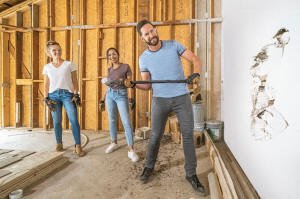US home flipping malaise pinches reality TV stars to contractors
 Send a link to a friend
Send a link to a friend
 [March 23, 2024]
By Amina Niasse [March 23, 2024]
By Amina Niasse
NEW YORK (Reuters) - While the increase in interest rates engineered by
the Federal Reserve over the last two years put a damper on the overall
U.S. housing market, it took a sledge hammer to home flippers from small
contractors to reality TV stars.
Just ask Tarek El Moussa, star of HGTV’s "The Flipping El Moussas" and
former co-host of the real estate and renovation focused channel's
mainstay, "Flip or Flop."
“How do I account for [interest rates]? I got my ass kicked last year. I
lost a lot of money. And that's just the reality of the business,” said
El Moussa.
Indeed, house flipping - or investing in, and often renovating, a
single-family home with the intent to sell for a profit - has fallen
from heights seen during the COVID-19 pandemic. The number of Americans
acting as investors in the housing market dived 38.85% between 2021 and
2023’s fourth quarter, according to property data provider ATTOM Data
Solutions. Through the fourth quarter of 2023, the share of homes
purchased by investors fell 11% on a year-over-year basis, a report from
real estate and mortgage firm Redfin said.
Even so, housing investors spent $32.3 billion on homes in the U.S. in
2023, compared with $33.6 billion a year earlier, and flippers bought
26% of the lowest-priced homes during 2023's fourth quarter, Redfin
said.

FRENETIC MARKET
HGTV's El Moussa bought 91 homes in 2021 - garnering him a $600,000
average monthly mortgage payment. Then mortgage rates surged, home sales
in southern California plunged, and he found himself with inventory he
could not offload.
Home flipping does best in a frenetic “buyer’s market,” with prices
rising amid increased transactions, said Chen Zhao, Redfin’s senior
economist. After the Fed began hiking rates in March 2022 to lower
inflation, buyers and sellers held off, creating gridlock in the housing
market.
Rates eventually reached a two-decade high near 8% in October, and the
resulting market has presented investors with the same issue home-buyers
face – limited inventory and lukewarm demand.
Rates have eased somewhat: Freddie Mac said on Thursday the average
30-year fixed-rate mortgage was 6.87%. Still, the current scene is a
striking departure from the onset of the pandemic when sub-4% mortgage
rates and heightened demand could promise a juicy profit.
LOWER MARGINS, LABOR TROUBLES
For Elisa Covington, an investor based in the San Francisco Bay Area, a
return on investment during 2021 often swung between 60% and 70%, she
said, occasionally hitting 100%.
"In 2021 and early 2022, my projects were getting much higher returns,"
Covington said. "But this year the profit margin for most of my projects
have been in line with my expectations" of 30% to 40%.
Lack of homebuyer demand would make it easier on investors looking for
single family homes, but reduced inventory has largely outweighed that,
cutting into acquisition trends.
Julio Martinez, co-owner and broker at JATS Properties in Los Angeles,
said "2023 was kind of weird." He acquired just six homes last year and
even that was due to several of the properties being in foreclosure. If
not for that, "we probably would’ve only done one or two."

[to top of second column]
|

HGTV's Flipping 101 host Tarek El Moussa begins a garage renovation
with homeowners in the garage, in Los Angeles, California, U.S.,
September 10, 2020. HGTV/Handout via REUTERS
 Some construction companies say
cooling home investment has cut into new business activity. Ghulam
Mustafa, owner of New-York based Sahara Builders, said the decline
in his firm's full-gut renovation projects since the pandemic has
caused a 40% decline in profit since 2021 through the end of 2023.
Last year “was much slower than the pandemic,” Mustafa said.
For contractors who don't build new homes, steady project supply in
the absence of gut-renovations is replaced by smaller-ticket
refurbishing projects for existing home-owners, RedFin's Zhao said.
For house flippers, meanwhile, lower profits have reduced the labor
they can hire for renovations, which can decelerate sales.
JATS Properties' Martinez had to let go of a full-time handyman, he
said. In addition to property flipping, his family-owned company
operates as brokers and property managers, so that labor loss meant
less attention to home-flip projects.
"We had to slow [workers] down on our projects, and lend them out to
our clients," said Martinez. "Typically we take first priority
because they're our employees. But when we don't have the funds to
cover our own projects, we have them work on our clients' homes.
It's taking the burden of expense of those employees off our backs."
FADING STARS
Amid the slow turnover, flippers are diversifying their activities.
Martinez, who saw transaction volume in 2023 fall by half from 2021,
began making property-secured loans to aspiring investors. And El
Moussa, who needed to gird for losses he knew were coming from
unsold flipper projects, shifted to buying home purchase contracts
wholesale and selling to investors, deals that typically net smaller
margins but are less risky than traditional flipping.
"In order to get prepared for those losses that were coming, I
stopped buying houses to flip and I only focused on wholesaling," he
said.
The story has changed for the house flipper reality TV landscape as
well.
HGTV ad revenue slid from a four-year high of $42.7 million in 2021
to $32.6 million in 2023, according to data from iSpot.TV, a
television ad measurement company, though it continues to hold
dominant share in its market segment.

Shows like The El Moussas have increasingly incorporated discussions
on rates, slow turnover, and price acceleration in Southern
California to keep viewers engaged, said Loren Ruch, head of home
content at HGTV. Show development focus has turned to standalone
secondary homes, for example a guest house, and multi-generational
living.
"People might not be spending huge amounts of money on design or
renovation projects, so we're also looking into a variety of shows
that are more approachable price points that are maybe based on not
doing as much demolition, but actually focusing on the space and the
configuration," said Ruch.
(Reporting by Amina Niasse; Editing by Dan Burns and Anna Driver)
[© 2024 Thomson Reuters. All rights
reserved.] This material may not be published,
broadcast, rewritten or redistributed.
Thompson Reuters is solely responsible for this content. |